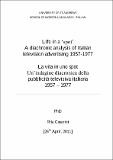Files in this item
La vita in uno spot : un'indagine diacronica della pubblicità televisiva italiana, 1957-1977
Item metadata
| dc.contributor.advisor | Riccobono, Rossella | |
| dc.contributor.author | Casarini, Rita | |
| dc.coverage.spatial | 251 | en_US |
| dc.date.accessioned | 2011-07-19T11:52:35Z | |
| dc.date.available | 2011-07-19T11:52:35Z | |
| dc.date.issued | 2011-06-21 | |
| dc.identifier | uk.bl.ethos.552575 | |
| dc.identifier.uri | https://hdl.handle.net/10023/1920 | |
| dc.description.abstract | The present dissertation investigates the role of television advertising in shaping the cultural values of the Italian society in the circular process of mirroring pre-existing societal values yet inducing new ones, thus contributing to its evolution. It questions its role within the society, its relationship with families, women and youngsters, the kind of language used in communicating, between 1957-1977, the age of Carosello programme. A corpus of two thousand five hundred television adverts was viewed and filed, of which a hundred were selected according to the more frequent themes, their cultural and semiotic relevance, and twenty-two analysed by a semiotic approach, together with some more considered alongside. Chapter One deals with methodology, an overview of the main concepts and tools of applied semiotics and the socio-semiotic perspective adopted. Chapter Two, then, contextualizes television advertising into its broader socio-cultural milieu and the history of television. The following three chapters analyze the selected adverts according to five main recurring themes: Chapter Three, the first steps of TV advertising, its auto-referentiality and its language; Chapter Four, the family and its inner relationships, the couple and the institution of marriage; Chapter Five women‘s emancipation, the new generation of youngsters and new myths. Commercials are analysed by shots and sequences from a narrative and visual perspective in search of their deep underlying generative values. The approach is a holistic one, adapting itself to the prevailing characteristics of every occurrence, although the peculiar nature of the ads of the period entails a prevailing narratological model. All findings are then connected together to identify the main semantic areas indicating cultural values present in the Italian society of the period. The end findings consist of a set of interesting cultural values identified. At first a self-assertiveness of advertising as a way to popularity; then its preferred mode of communication through verbal language rather than pictures; a representation of families according to either the patriarchal or the consumerist model; a fundamental disbelief in marriage and a sexist attitude to women‘s representation; finally, a mistrust in the values of the new generations. All of these eventually pointing to the main semantic area of tradition, an index to the fundamental conservative yet contradictory role of the Carosello adverting which, while contributing to preserve traditional values, it also tended to replace them with its only main consumerist value. At a higher level, on a socio-semiotic perspective it is the role of that semiosphere which, while drawing from society it also contributes in shaping it. | en_US |
| dc.language.iso | it | en_US |
| dc.publisher | University of St Andrews | |
| dc.rights | Creative Commons Attribution-NonCommercial-NoDerivs 2.5 UK: Scotland | |
| dc.rights.uri | http://creativecommons.org/licenses/by-nc-nd/2.5/scotland/ | |
| dc.subject | Advertising | en_US |
| dc.subject | Television | en_US |
| dc.subject | Italian advertising | en_US |
| dc.subject | Semiotics | en_US |
| dc.subject.lcc | HF6146.T42C2 | |
| dc.subject.lcsh | Television advertising--Social aspects--Italy | en_US |
| dc.subject.lcsh | Semiotics in advertising | en_US |
| dc.title | La vita in uno spot : un'indagine diacronica della pubblicità televisiva italiana, 1957-1977 | en_US |
| dc.title.alternative | Life in a 'spot‘ : a diachronic analysis of Italian television advertising, 1957-1977 | en_US |
| dc.type | Thesis | en_US |
| dc.type.qualificationlevel | Doctoral | en_US |
| dc.type.qualificationname | PhD Doctor of Philosophy | en_US |
| dc.publisher.institution | The University of St Andrews | en_US |
This item appears in the following Collection(s)
Except where otherwise noted within the work, this item's licence for re-use is described as Creative Commons Attribution-NonCommercial-NoDerivs 2.5 UK: Scotland
Items in the St Andrews Research Repository are protected by copyright, with all rights reserved, unless otherwise indicated.


